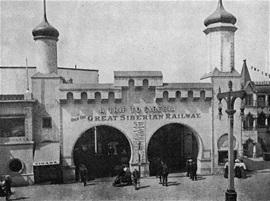 This is the building that housed the Trans-Siberian Train Panorama in St. Louis, MO. 1904, photo from Wikipedia.
This is the building that housed the Trans-Siberian Train Panorama in St. Louis, MO. 1904, photo from Wikipedia.
Many moving panoramas focused on travel to distant lands at a time when travel was still a big undertaking. These early 20th Century moving
panoramas and related artforms involved travel by train.
Part One: The first two moving panoramas on this page:
- From London to Paris (1905)
- The Great Siberian Route, The Trans-siberian Railway Panorama by
Pavel Pyasetsky (1900)
are "crankie-sized," parlor panoramas. The scrolls are between 15"-18" high.
PART
TWO: The second three examples uses the "scene from a train window" theme in a type of amusement park attraction.
- The Panorama Transsberian (1900) - commission by Wagon-Lits, painted by Jambon and Bailly.
- Scene from the movie "Letter From an Unknow Women" (1948)
- Hales's Tours of the World (1905) a company which used film instead of moving panoramas to create the illusion of passing scenery.